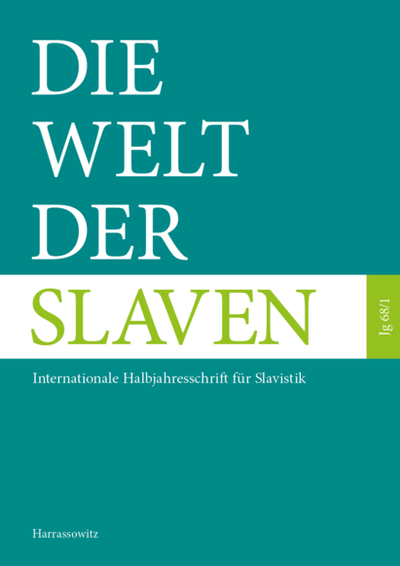Variabilität in der Wortfolge
Eine Korpusanalyse zu polnischen Adjektiv-Substantiv-Konstruktionen
DOI:
https://doi.org/10.13173/WS.68.1.075Schlagwörter:
Nominalphrase, Wortstellung, Korpusanalyse, VariabilitätAbstract
Variability in word order: A corpus analysis of Polish adjective–noun constructions
In Polish noun phrases, adjectives may precede the noun (AN) or follow it (NA), such as in grzecznyA człowiekN ‘polite person’ and falaN dźwiękowaA ‘sound wave’. The bulk of the literature on this issue is theoretical in nature and discusses semantic factors determining adjective placement for different types of constructions, as well as specific conditions (syntactical context, information structure) that result in deviations from this default word order. In contrast, this study is based on a quantitative analysis of AN and NA constructions in the Polish National Corpus and aims to evaluate the amount of word order variability within the same adjective–noun combination. For this purpose, 737 randomly chosen constructions were analyzed with regard to the frequency of their occurrences in AN and NA. Unexpectedly, more than one-third of the constructions appear in more or less balanced proportions, indicating that variability of word order plays a much bigger role than previously assumed.
Literaturhinweise
Bermel, Neil. 2015. Corpora and quantitative data in Slavic languages. Russian Linguistics 39. 275–282.
Biber, Douglas & Johansson, Stig & Leech, Geoffrey & Conrad, Susan & Finegan, Edward. 2010. Longman Grammar of Spoken and Written English. 8th edn. Harlow.
Bielec, Dana. 1998. Polish: An essential grammar. London.
Bogusławski, Andrzej. 2001. Szyk uzupełnień w polskich frazach imiennych. In Gruszczyński, Włodzimierz & Andrejewicz, Urszula & Bańko, Mirosław & Kopcińska, Dorota (red.), Nie bez znaczenia…: Prace obfiarowane Profesorowi Zygmuntu Saloniemu z okazji jubileuszu 15 000 dni pracy naukowej, 79–86. Białystok.
Bouchard, Denis. 1998. The distribution and interpretation of adjectives in French: A consequence of Bare Phrase Structure. Probus 10(2). 139–183.
Bouchard, Denis. 2002. Adjectives, number and interfaces: Why languages vary. Oxford.
Buttler, Danuta & Kurkowska, Halina & Satkiewicz, Halina. 1971. Kultura języka polskiego. Warszawa.
Brooks, Maria Zagorska. 1975. Polish Reference Grammar. The Hague.
Cetnarowska, Bożena & Pysz, Agnieszka & Trugman, Helen. 2011. Accounting for some flexibility in a rigid construction: On the position of classificatory adjectives in Polish. In Bański, Piotr & Łukaszewicz, Beata & Opalińska, Monika & Zaleska, Joanna (eds.), Generative investigations: Syntax, morphology, and phonology, 24–47. Newcastle upon Tyne.
Clasmeier, Christina. 2019. Zielona przestrzeń, teren zielony – eine Korpusuntersuchung zur Wortstellung polnischer Farbadjektive. In Böhnisch, Genia & Junghanns, Uwe & Pitsch, Hagen (Hg.), Linguistische Beiträge zur Slavistik: XXV. JungslavistInnen-Treffen in Göttingen, 13.–16. September 2016, 55–70. Berlin.
Clasmeier, Christina. 2020. Niebieski ptak und cukier biały – Eine Klassifikation und Korpusanalyse der Funktion und Wortfolge polnischer Farbadjektive. Zeitschrift für Slawistik 65(1). 96–133.
Clasmeier, Christina. (Angenommen.) Funktionen attributiver Adjektive im Polnischen: Zwei Prototypenmodelle. Erscheint in Clasmeier, Christina & Golbek, Julia (Hgg.), Linguistische Beiträge zur Slavistik: XXIX. Jungslavist*innen-Treffen in Bochum, 09.–10. September 2021.
Clasmeier, Christina. (In Vorbereitung.) Freie Varianten? Eine regressionsanalytische Untersuchung zur Wortfolgevariabilität polnischer attributiver Adjektive (geplant als Zeitschriftenartikel).
Downing, Pamela. 1977. On the creation and use of English compound nouns. Language 53. 811–842.
Dryer, Matthew S. 2013. Order of adjective and noun. In Dryer, Matthew S. & Haspelmath, Martin (eds.), The World Atlas of Language Structures Online. http://wals.info/chapter/87.
Fuß, Eric & Konopka, Marek & Wöllstein, Angelika. 2019. Grammatik im Korpus: Korpuslinguistisch-statistische Analyse morphosyntaktischer Variationsphänomene. Tübingen.
Gaertner, Henryk. 1924. O szyku przymiotników. Warszawa.
Halliday, Michael Alexander Kirkwood. 1991a. Towards probabilistic interpretations. In Ventola, Eija (ed.), Functional and systemic linguistics: Approaches and uses, 39–61. Berlin.
Halliday, Michael Alexander Kirkwood. 1991b. Corpus studies and probabilistic grammar. In Ajimer, Karin & Altenberg, Bengt (eds.), English corpus linguistics, 30–43. London.
Hansen, Björn. 1994. Determinatorenserialisierung in den slavischen Sprachen. Ein typologisch-kognitiver Erklärungsvorschlag. Wiener Slawistischer Almanach 33. 119–128.
Koch, Peter & Oesterreicher, Wulf. 1986. Sprache der Nähe – Sprache der Distanz: Mündlichkeit und Schriftlichkeit im Spannungsfeld von Sprachtheorie und Sprachgeschichte. Romanistisches Jahrbuch 36. 15–43.
Koch, Peter & Oesterreicher, Wulf. 1994. Schriftlichkeit und Sprache. In Günther, Hartmut & Ludwig, Otto (Hg.), Schrift und Schriftlichkeit: Ein interdisziplinäres Handbuch internationaler Forschung, 1. Halbband, 587–604. Berlin.
Krasnowolski, Antoni. 1909. Systematyczna składnia języka polskiego. Warszawa.
Lehmann, Volkmar. 2013. Linguistik des Russischen: Grundlagen der formal-funktionalen Beschreibung. München.
Levi, Judith N. 1978. The syntax and semantics of complex nominals. New York.
Linde-Usiekniewicz, Jadwiga. 2016. A position on classifying and qualifying adjectives revisited. Studies in Polish Linguistics 2(11). 57–84.
Makùrôt, Hana. 2016. Gramatika kaszëbsczégò jãzëka. Gdańsk.
Nowicka-Schwartz, Aldona Antonina. 1980. Ordering of attributive adjectives in Polish. Ann Arbor.
Plungjan, Wladimir A. & Stojnova, Natalʹja M. & Dobrušina, Ekaterina R. & Rachilina, Ekaterina V. 2016-2018. Materialy k korpusnoj grammatike russkogo jazyka. Teile I–III. Sankt-Peterburg.
Przepiórkowski, Adam & Bańko, Mirosław & Górski, Rafał & Lewandowska-Tomaszczyk, Barbara. 2012. Narodowy korpus języka polskiego. Warszawa.
Radatz, Hans-Ingo. 2001. Die Semantik der Adjektivstellung: Eine kognitive Studie zur Konstruktion ‚Adjektiv + Substantiv‘ im Spanischen, Französischen und Italienischen. Tübingen.
Siewierska, Anna & Uhlířová, Ludmila. 1998. An overview of word order in Slavic languages. In Siewierska, Anna (ed.), Constituent order in the languages of Europe, 105–149. Berlin.
Skorupka, Stanisław. 1974. Słownik frazeologiczny języka polskiego. Warszawa.
Sussex, Roland. 1975. Attributive adjectives in Polish. International Journal of Slavic Linguistics and Poetics 3. 23–46.
Szucsich, Luka & Haider, Hubert. 2015. Freie Wortstellung in slavischen Sprachen und die VO/OV-Unterscheidung. In Dieser, Elena (Hg.), Linguistische Beiträge zur Slavistik 20, 159–189. München.
Szymanek, Bogdan. 2010. A panorama of Polish word-formation. Lublin.
Tabakowska, Elżbieta. 2007. Iconicity and linear ordering of constituents within Polish NPs. In Divjak, Dagmar & Kochańska, Agata (eds.), Cognitive paths into the Slavic domain, 411–430. Berlin.
Warren, Beatrice. 1984. Classifying adjectives. Göteborg.
Zemskaja, Elena A. 2004. Otnositelʹnoe prilagatelʹnoe kak specifičeskij klass proizvodnych slov. In Zemskaja, Elena A., Jazyk kak dejatelʹnostʹ: Morfema, slovo, rečʹ, 158–196. Moskva.

